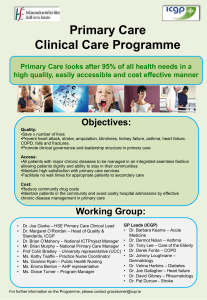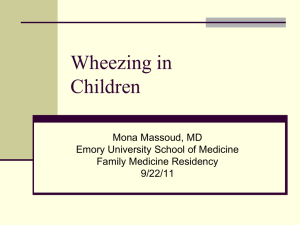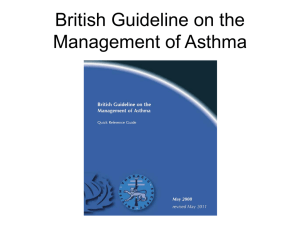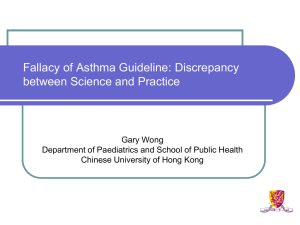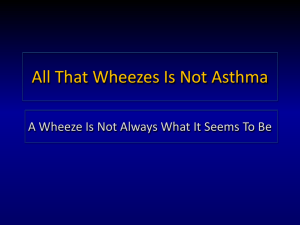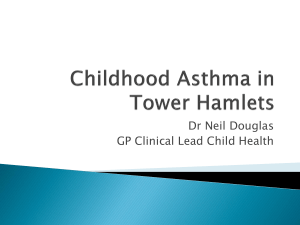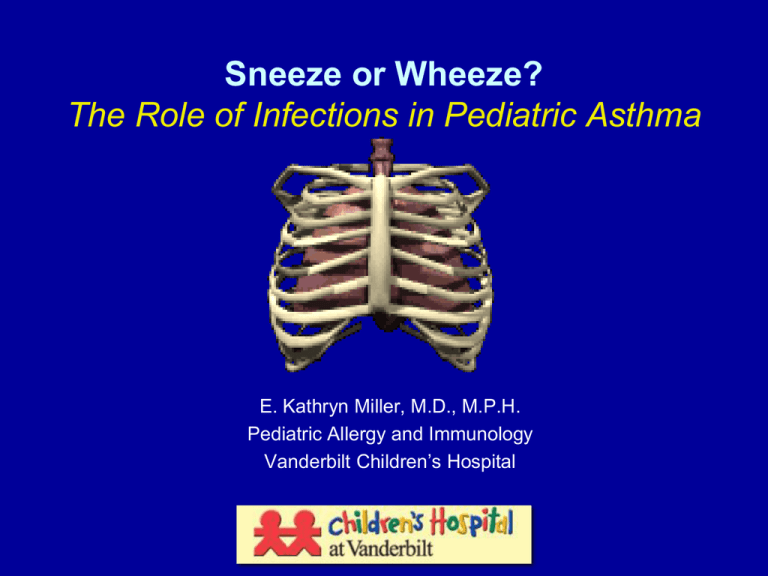
Sneeze or Wheeze?
The Role of Infections in Pediatric Asthma
E. Kathryn Miller, M.D., M.P.H.
Pediatric Allergy and Immunology
Vanderbilt Children’s Hospital
Disclosures:
E. Kathryn Miller
• Financial: no conflicts
of interest to disclose
• Research: funded by
NIH K23, NIH R03,
March of Dimes Basil
O’Conner, and
VCTRS K12 awards
• Organizational:
AAAAI, AAP
• Gifts: nothing to
disclose
• Legal Consult/Expert
Witness: nothing to
disclose
• Other: nothing to
disclose
• Employment:
Vanderbilt University
Case: “She can’t breathe!”
• 2 y/o “asthmatic” with wheezing in September
– 2 day h/o rhinorrhea and cough
– 1 day h/o wheezing and increased work of breathing
• Social/Family History
– + daycare, + smoking, + maternal asthma
• Physical Exam
– Tachypnea, hypoxia
– Expiratory wheezes bilaterally, subcostal retractions
Chest X-Ray
Hospital Course
• In Emergency Room
– Continuous albuterol, oral steroids, O2, Mg
– No improvement in 4+hrs, increased respiratory distress
• In Pediatric ICU
– Terbutaline drip, Solu-Medrol q6h, Atrovent q6h
– Weaned over 5 days
• Home
– Pulmicort bid, prn albuterol, prednisone taper, smoking
education
What is the most likely
infectious trigger?
A)
B)
C)
D)
RSV (respiratory syncytial virus)
Streptococcus pneumonia
Influenza
HRV (human rhinovirus)
RT-PCR of Nasal Swabs
RSV A and B: negative
Influenza A and B: negative
Human Rhinovirus (HRV): positive
•
VP4/VP2 sequencing: HRVC
What infection during infancy is
most associated with the
subsequent development of
childhood asthma?
A)
B)
C)
D)
RSV (respiratory syncytial virus)
Streptococcus pneumonia
Influenza
HRV (human rhinovirus)
Which of the following appears to
be associated with asthma?
A) Influenza
B) HRV (human rhinovirus)
C) hMPV (human metapneumovirus)
D) Chlamydia pneumonia
E) All of the above
Overview:
Infections and Asthma in Pediatrics
• Viral Infections: Ontogeny of Asthma
• Viral Infections: Exacerbation of Asthma
• Infant and Toddler Wheezing Phenotypes
• Treatment of Recurrent Wheezing
Ontogeny of Asthma:
Viral infections are important in
the development of asthma.
Ontogeny of Asthma: Infections Helpful?
Hygiene Hypothesis
Changes in Society
(
family size, improved sanitation, etc…)
Decreased Childhood Infections
Cytokine Imbalance
Th1>>>Th2 phenotype
(favors atopic disease, asthma)
Strachan 1989
Ontogeny of Asthma: Infections Harmful?
Bronchiolitis-to-Asthma
• RSV bronchiolitis in infancy is an important risk factor
for asthma and allergy at age 7.1
• HRV hospitalizations during infancy are an early
predictor of subsequent asthma development. 2
• 1st year wheezing with HRV is the strongest viral
predictor of wheezing at 3 yrs age (OR 6.6). 3
1. Sigurs AJRCCM 2000; ; 2. Kotaneimi-Syrjanen JACI 2003; 3. Lemanske JACI 2005
Early HRV Wheezing Is Most
Associated With Childhood Asthma
Jackson AJRCCM 2008
Early HRV Wheezing Is Most
Associated With Childhood Asthma
•In Year 3:
HRV (OR 25.6) >> AE sensitization (OR 3.4)
as risk factor for asthma at age 6
*90% of children who wheezed with HRV in Yr 3
had asthma at age 6
Jackson AJRCCM 2008
Differential Effect of Infant RSV vs. HRV
Bronchiolitis on Early Childhood Asthma
Proportion developing asthma
N = 1,676
N = 8,544
Dec – Feb
RSV predominant months
May, August & Sept
HRV predominant months
Tennessee Asthma and Bronchiolitis Study
Carroll JACI 2009
Does Bronchiolitis Severity
Predict Risk of Asthma?
Severity score: high score by age 2 years may
predict asthma at age 10 yrs
Devulapalli Thorax 2008
Exacerbation of Asthma:
Many viruses are important in
asthma exacerbations.
Exacerbation of Asthma
• ~85% of children with asthma flare have virus.
1,2
• Among children hospitalized for wheezing, respiratory
syncytial virus (RSV), influenza virus, and human
rhinovirus (HRV) are most common in those <3 years;
HRV in older. 3
• Bacterial causes: Atypical bacteria and sinusitis
1. Johnston BMJ 1995; 2. Nicholson BMJ 1993;
3. Heymann JACI 2004
Emerging Knowledge: Viruses
• Human Metapneumovirus (hMPV)
• Human Coronaviruses (hCoV)
• Human Rhinovirus C (HRVC)
The New Vaccine Surveillance Network
(NVSN)
Prospective, population-based surveillance: 2000-2006
Children <5 yrs hospitalized
with acute respiratory
illness (ARI) or fever
Sites
Rochester, NY
Nashville, TN
Cincinnati, OH (2001)
NVSN Year 1: Viruses Identified in 70% of
Hospitalized Children With ARI or Fever
No Virus
30%
EV
AdV
Flu
hMPV 4%
hCoV
HRV 26%
PIV
RSV
29%
Iwane Pediatrics 2004; Mullins EID 2004; Miller JID 2007;
Dare, unpublished data
HMPV Causes Fever/ARI in
Young Children
RSV URI
Bronchiolitis
Asthma
Pneumonia
26/668 (4%) hMPV+
Mullins EID 2004
In various studies, 14-67% of children with hMPV have been
diagnosed with asthma exacerbation, vs. 0-15% with other viruses.
Coronaviruses (HCoV) in 2-5% of
Hospitalized Children in NVSN Study
Croup
Bronchiolitis
Other
Asthma
Pneumonia
• Year 1: 27/551 (4.9%)
– Primarily OC43 and 229E
•Years 2-3: 23/1048 (2.2%)
–Primarily NL63
Dare et al
Talbot et al
RV ARI Hospitalizations per 1000
Persons
HRV Associated With Significant
Burden in Hospitalized Children
20
(18)
15
(6)
10
5
Davidson Co., TN
Monroe Co., NY
(2)
0
<6 months
6-23
months
Age
24-59
months
HRV Species Have Different Clinical
Phenotypes
Seasonality of HRV Clades
20
15
HRV- A
HRV- B
10
HRV- C
5
0
Jul
Aug
Sept
Oct
Nov
Dec
Jan
Feb
Mar
Apr
May
Jun
•HRVC (new):
•HRVA (classic):
–More dual infections* –More cough*
–More wheezing*
–Fever*
–More discharge diagnoses
of asthma*
*p<0.05
Mechanisms of Viral Wheeze
• Airway epithelial cells1
– Normal: apoptosis
– Asthma: viral replication
• Immune dysregulation1-5
– Altered innate immune responses
• Type 1-3 interferons (, , , )
• Genetic polymorphisms6, 7
– CD14_159 and Toll 3 receptors
1. Contoli M et al. Nat Med 12:1023, 2006
5. Miller EK et al. AJRCCM, 2011
2. Wark PA et al. J Exp Med 201:937, 2005
6. Hewson CA et al. J Virol 79:12273
3. Copenhaver CC et al. AJRCCM 170:175, 2004
7. Martin AC et al. AJRCCM 173:617, 2006
4. Parry DE et al. JACI 105:692, 2000
Viral Wheezing <2 Years Age
• Viral etiologies
– RSV > HRV > influenza, HMPV, coronavirus,
PIV
• Risk factors:
– Environmental tobacco smoke exposure
– Reduced lung function
– (Lack of breastfeeding)
Viral Wheezing in Older
Children
• HRV >>>> others
– September “asthma epidemic”
• Often have
– elevated IgE
– inhalant allergen sensitization
– maternal asthma
Infection and Susceptibility
• Patients with asthma do not appear to be
more susceptible to infection with HRV
• They are more likely to have lower
respiratory symptoms with more protracted
and severe course
Infant and Toddler
Wheezing Phenotypes
Childhood Wheezing
• 50% of kids reported to have wheezing in
1st year of life
• 15% outpatient visits, 3% hospitalizations
for wheezing
• 20% continue to later childhood
Martinez NEJM 1995
Wheezing Phenotypes
• 51% never wheeze
• Of those who wheeze:
– Early, transient wheeze (60%) - began by 3,
resolved by 6
– Non-atopic persistent wheeze (20%) - began
by 1, persisted to 6, fade by adolescence
– Atopic (IgE-associated) persistent wheeze
(20%) – often begin after age 1, persist to
late adolescence
Tuscon Classification (n=1246)
Risk Factors for Persistent
Wheezers
• Non-atopic:
– Lower lung function, enhanced airway
reactivity, low socioeconomic status
• Atopic:
– Parental asthma, male sex, atopic dermatitis,
eosinophilia at 9 months, h/o wheeze with
LRI, early sensitization to food, aeroallergens,
symptoms between exacerbations
Asthma Risk Factors
• Atopy
– Food/inhalant sensitization associated with
persistent wheezing age 6
– Alternaria allergy associated with chronic
asthma age 22
• Reduced lung function (age uncertain)
– Tuscon study: normal function as infant,
reduced by age 6 in asthmatics at age 22
– Norway/Australia studies: reduced function in
infancy in persistent wheezers age 10-11
• Viral Infections: HRV synergistic
Will My Child Get Asthma?
Modified Asthma Predictive Index
History of 4+ wheezing episodes with at least one diagnosed by MD
Child must meet at least 1 major or 2 minor criteria:
Major:
Parental history of asthma
Physician-diagnosed atopic dermatitis
Allergic sensitization to 1+ aeroallergen
Minor:
Allergic sensitization to milk, egg, or peanut
Wheezing unrelated to viral illness
Serum eosinophils >4%
(PPV 47.5-51.5%, NPV 91.6% for asthma age 6-13)
Adapted from Guilbert et al JACI 2004
Approach to the Infant/Toddler
with Persistent Wheezing
Medical History
• Timing, pattern of wheezing
• Cough or limitation outside of exacerbations
• Association with feeding, failure to thrive,
unresponsive to B2-adrenergics: other
diagnosis?
• Comorbidities: GER, rhinitis, sinusitis
Therapy for Infant/Toddler
Recurrent Wheeze
• Based on 2007 NAEPP asthma guidelines
for 0-4 years old if “asthma-like”
• Sx’s <2d/wk: prn short acting B agonist
• Persistent sx’s >2d/wk: low dose ICS
– Consider RISK for step-up therapy:
• 2+ oral steroids in 6 months?
• 4+ episodes/yr >1 day wheeze and risk factors for
persistent asthma?
Classifying Severity in Patients 0-4 Years of Age
Not Currently Taking Long-Term Controllers
Persistent
Components of Severity
Impairment
Intermittent
Moderate
Severe
Symptoms
<2 days/week
>2 days/week but not
daily
Daily
Throughout the
day
Nighttime awakenings
0
1-2x/month
3-4x/month
>1x/week
SABA use for symptom
control (not EIB
prevention)
< 2 days/week
>2 days/week but not
daily
Daily
Several times per
day
Interference with normal
activity
None
Minor limitation
Some
limitation
Extremely limited
0-1/ year
Risk
Mild
Exacerbations requiring
oral systemic
corticosteroids
Consider severity and interval since last exacerbation.
Frequency and severity may fluctuate over time.
Exacerbations of any severity may occur in patients in any severity.
Step 1
Recommended Step for
Initiating Treatment
>2 exacerbations in 6 months requiring oral systemic
corticosteroids, or >4 wheezing episodes/1 year lasting >1
day AND risk factors for persistent asthma
Step 2
Step 3 and consider short course of
oral systemic corticosteroids
In 2 to 6 weeks, depending on severity, evaluate level of asthma control that is
achieved. If no clear benefit is observed in 4-6 weeks, consider adjusting
therapy or alternative diagnoses.
EIB- exercise-induced bronchospasm; SABA= short-acting beta agonist; National Asthma Education and Prevention Program. Expert Panel Repot 3:
Guidelines for the Diagnosis and Management of Asthma (EPR 3-2007). U.S. Department of Health and Human Services. Available at
http://www.nhlbi.nih.gov/guidelines/asthma/asthgdln.pdf. Accessed August 29, 2007.
Assessing Asthma Control in Patients 0-4 Years of Age
Well
Controlled
Not Well
Controlled
Very Poorly
Controlled
Symptoms
<2 days/week
>2 days/week
Throughout the day
Nighttime awakenings
<1x/month
>1x/month
>1x/week
SABA use for symptom
control (not EIB
prevention)
< 2 days/week
>2 days/week
Several times per day
Interference with
normal activity
None
Some limitation
Extremely limited
0-1 / year
2-3 / year
>3 / year
Components of Control
Impairment
Risk
Exacerbations requiring
oral systemic
corticosteroids
Treatment-related
adverse events
Recommended Action for
Treatment
Medication side effects can vary in intensity from none to very troublesome and
worrisome. The level of intensity does not correlate to specific levels of control
but should be considered in overall risk assessment.
•Maintain current
treatment
•Regular f/u every 1-6
months
•Consider step-down
if well controlled for
at least 3 months
•Step up (1 step) and
•Reevaluate in 2-6 weeks
•If no clear benefit in 46wks, consider
alternative diagnoses or
adjusting therapy
•For side effects,
consider alternative
treatment options
•Consider short course of oral
systemic corticosteroids
•Step up (1-2 steps) and
•Reevaluate in 2 weeks
•If no clear benefit in 4-6 wks,
consider alternative diagnoses of
adjusting therapy
•For side effects, consider
alternative treatment options
National Asthma Education and Prevention Program. Expert Panel Report 3: Guidelines for the Diagnosis and Management of Asthma (EPR 3-2007).
U.S. Department of Health and Human Services. Available at L http://www.nhlbi.nih.gov/guidelines/asthma/asthgdln.pdf. Accessed August 29, 2007.
Stepwise Approach for Managing
Asthma in Children 0-4 Years of Age
http://www.nhlbi.nih.gov/guidelines/asthma/asthgdln.htm
Treatment for Recurrent Viral
Wheeze in Young Children
• Important: ICS may control symptoms, do not
alter lung function or subsequent symptoms1,2
• In subset with recurrent wheeze, daily low dose
ICS not superior to intermittent high-dose ICS in
reducing exacerbations3
1. Guilbert NEJM 2006; 2. CAMP NEJM 2000; 3. Zeiger NEJM 2011
Intermittent Medications for
Viral-Induced Wheeze
Inhaled Short-Acting BetaAgonists
• First-line therapy
• Effective rescue from symptoms,
especially if established asthma
• Not shown to improve clinical outcomes,
decrease hospitalization, or decrease
duration of hospitalization in children with
bronchiolitis
Gadomski Cochrane Database 2006
? Inhaled Hypertonic Saline
Plus B-Agonist ?
• Hypothesis: viral infection (HRV) leads to
dehydration of airway surface liquid and
impaired mucous clearance1-3
• Small trial: 41 aged 1-6 with wheeze in ER
randomly assigned albuterol plus 5% vs
0.9% saline. LOS, hospitalization lower in
HS. 4
1. Daviskas J Aerosol Med 2006; 2. Randell AJRCMB 2006; 3. Mandelberg
Pediatr Pulmonol 2010; 4. Ater Pediatrics 2012
Intermittent HIGH Dose Inhaled
Corticosteroids (ICS)
• Started at onset of URI and continued up to
10 days may decrease symptoms and need
for oral steroids (fluticasone 750mcg bid1,
budesonide 1mg bid2 studied, and others3-5)
• Maybe slight growth deficits?
• Unsure if effective if started after wheezing
begins?
• Perhaps good in patient with asthma risk
1. Ducharme NEJM 2009; 2. Zeiger NEJM 2011; 3. Connett Arch Dis Child
1993; 4. McKean Cochrane Review 2000; 5. Papi Allergy 2009
Intermittent STANDARD (lowmedium) Dose ICS
• Intermittent dosing NOT effective in this
population
• Particularly not if started after wheezing
begins
• Daily use effective to prevent episodes
(discussed later)
Intermittent Systemic
Corticosteroids
• Mixed data for treating virus-induced
wheeze in preschoolers, but overall NOT
EFFECTIVE
• Alternatively, initiating systemic CS at
earliest signs of viral URI MAY prevent
wheeze
– Response may differ by virus
– Unsure if response differs by atopy status?
Jarrti PAI 2007
Intermittent Leukotriene
Antagonists
• Mixed data
• One study with reduced severity on LTRA
or ICS compared with placebo1
• One study with reduced visits, symptoms
in LTRA vs placebo, but no difference in
rescue medication or hospitalization2
• One study with no difference in asthma
episode frequency3
1. Bacharier JACI 2008; 2. Robertson AJRCCM 2007; 3. Valovirta Ann Allergy
Asthma Immunol 2011
Daily Therapy for Viral-Induced
Wheeze
Daily Inhaled Glucocorticoids
(ICS)
• Standard doses of daily ICS are effective
in preventing episodic virus-induced
wheezing in young children. 1-3
• Data from 16 RCTs: patients on daily ICS
had fewer wheezing exacerbations
compared with placebo (18 vs 32%,
RR0.059, CI 0.52-0.67) 1
• Independent of atopy and age
1. Castro-Rodriguez Pediatrics 2009;2. Guilbert JACI 2011; 3. Papi Allergy 2009
Daily Leukotriene Antagonists
• In 550 children 2-5 years age,
monteleukast reduced rate of
exacerbations by 32% and time to first
exacerbations by 2 months c/w placebo1
• Need for oral steroids not different
• Other study with comparable time to first
episode among monteleukast vs
budesonide, but exacerbation rates lower
with budesonide2
1. Bisgaard AJRCCM 2005; 2. Szefler JACI 2007
Punchline:
Treatment of Viral Wheeze
• Short-acting B-agonist (albuterol) in NS
• NOT inhaled steroid
• NOT oral steroid, unless severe symptoms
and risk factors for persistent asthma or
already on controller ICS
Punchline:
Prevention of Viral Wheeze
• Intermittent high-dose steroids begun at
onset of URI, up to 10 days
• NOT oral steroid at onset of URI, unless h/o
hospitalization, high risk,
• Daily standard dose ICS if continued
episodes despite intermittent high dose ICS
or prior if h/o frequent oral steroids
• Intermittent or daily monteleukast is an
alternative
Key Points
• Ontogeny of Asthma: Viral infections appear to be
important in the development of asthma. Geneenvironment interaction most likely.
• Exacerbation of Asthma: Several new viruses
appear to be important in asthma exacerbations.
• Wheezing Phenotypes may help predict risk and
guide treatment
• Treatment of Episodic Viral Wheeze is under
investigation but generally follows asthma
guidelines
Acknowledgements
•
Vanderbilt Collaborators
–
–
–
–
–
–
•
Fernando Polack, MD
John Williams, MD
Kathy Edwards, MD
Tina Hartert, MD, MPH
Marie Griffin, MD, MPH
Stokes Peebles, MD
•
–
–
•
Jodell Jackson, PhD
Yassir Mohammed
Johanna Hernandez-Zea
Amy Podsiad
Laura-Lee Morin
Sharon Tollefson
Luke Heil
David Kraft
Reagan Cox
Jim Crowe, MD and Lab
•
Centers for Disease Control
University of Rochester
University of Cincinnati
Funding
–
–
–
–
•
Donna Hummell, MD
Paul Moore, MD
NVSN Group
–
–
–
Lab Group
–
–
–
–
–
–
–
–
–
–
Vanderbilt Department of Pediatrics,
Division of Pulmonary, Allergy and
Immunology
NIH K12 VCTRS, NIH T32, NIH K23, NIH
R03, NIH LRP
March of Dimes Basil O’Connor Award
MedImmune Award
Thrasher Research Fund
Research Nurses
–
–
Ann Clay, RN
Diane Kent, RN
Ontogeny of Asthma: Non-viral
Infections?
• Hypopharyngeal bacterial colonization in
asymptomatic infants is associated with
wheezing/asthma by age 5.
– S. pneumoniae, H. influenza, M. catarrhalis
(not S. Aureus)
Bisgaard et al. NEJM 2007; 357: 1487
Bacterial Infections and
Exacerbation of Asthma
• Generally unusual for bacterial respiratory
infections to trigger asthma, even in setting of
pneumonia.
• However, the following may precipitate worsening
of asthma:
– Chronic sinusitis (often bacterial)
– Respiratory infections with Mycoplasma or Chlamydia
pneumoniae
Virant Ped Ann 2000:29:434
Tsao Chest 2003;123:757
Biscardi Clin Infect Dis 2004; 38:1341
Emre Arch Ped Adol Med 1994; 148: 727
Webley Am J Rep Crit Care Med 2005;171:1083
Ontogeny of Asthma: When does
airway inflammation begin?
•
BAL in wheezing children < 3 yrs old
– inflammatory cells
– inflammatory mediators (leukotrienes)
Krawiec AJRCCM 2001 163:1338
• Bronchial biopsies in wheezing infants and toddlers with
reversible airflow obstruction
– No thickness of laminar reticularis
– No in inflammatory cells
Saglani AJRCCM 2005 171:722
•
Reticular BM thickening from 3mo-5yrs age
Saglani S et al. AJRCCM 176:858, 2007
September Asthma Epidemic
• Asthma hospitalizations in school-aged children
in Canada
– After return to school from summer/other breaks
• "September asthma epidemic"
– 18 days after Labor Day
– Lesser increase in attacks
• 2 days later in preschoolers
• 6 days later in adults
• Viral infections were presumed cause
Johnston et al. JACI 2006; 117:557
Etiology of Wheezing in First 6
Years of Life
Jackson AJRCCM 2008
Asthma and Invasive
Pneumococcal Disease
• Asthma is a risk factor for invasive
pneumococcal disease.
– Advisory Committee on Immunization
Practices recently voted 14/0 to recommend
vaccination in all asthmatics.
Talbot et al. NEJM 2005; 352: 2082.
Birth 4 Months Before Winter Virus Peak >> 29% Increased Odds of Asthma
Wu AJRCCM 2008;178:1123-9
Human Bocavirus
• Novel parvovirus identified in Swedish
children with respiratory disease
– 17/540 (3%) children
– Related to bovine and canine parvoviruses
• Bocavirus prevalence 4-11%
Allander CID 2005
Rhinovirus 16 with ICAM-1
Receptor Binding Sites
Genome of HRV
• Single-stranded positive sense RNA
Respiratory Virus Identified in
88% of 728 Jordanian Children
Vanderbilt Vaccine Clinic Lower
Respiratory Illness (LRI) Study
•2,009 healthy children over 25 years
• 687 LRI visits with nasal wash samples
-RSV (15% of all LRI)
• Total 41% previous viral diagnosis
•49/248 (20%) virus-negative samples MPV+
–12% of total LRI in this cohort
–Mostly bronchiolitis
–Not found in asymptomatic children
Williams NEJM 2004
Human Rhinoviruses (HRV)
• Member of the Picornaviridae family
identified in 1956
• Over 100 serotypes identified
– HRVA, HRVB groups until recently
• Seasonality
• Major cause of common cold
• Recent studies demonstrate role
in LRI/asthma
HRVC forms a distinct
and diverse group
HRVC in Hospitalized Children
<5 Yrs in Amman, Jordan
• 467/728 (64%) RSV+
• 266/728 (37%) HRV+
• 133 (66%) HRVA
• 7 (4%) HRVB
• 61 (30%) HRVC
• HRVC more associated with wheezing and
supplemental oxygen than HRVA
Halasa et al


